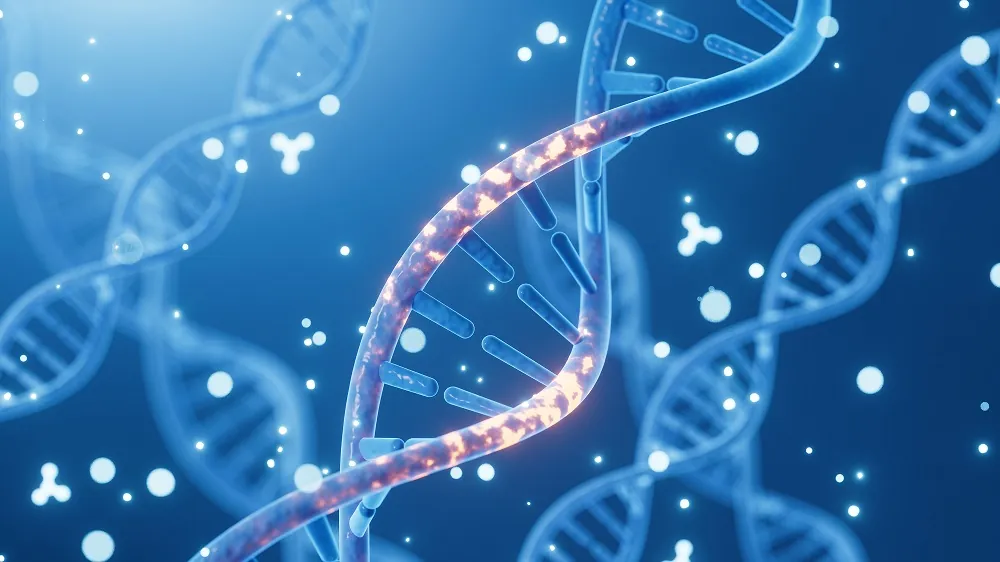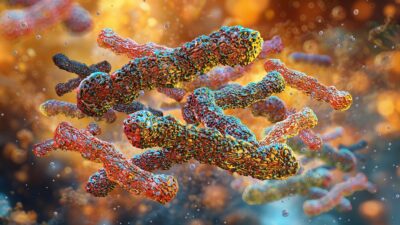Rejuvenating Cells with Epigenetic Reprogramming
- This approach shows promising results in preclinical studies.

The authors of a recent review published in Ageing Research Reviews summarize the research on epigenetic reprogramming and its potential as a rejuvenation therapy [1].
Epigenetics in aging
Aging leads to changes in the epigenome. Those changes can lead to alterations in gene regulation, affecting cellular homeostasis, and can play a role in age-associated phenotypes. Epigenetic modifications, the addition or removal of chemical groups to the DNA or DNA-associated proteins, have a profound impact on gene expression, tissue functions, and identity [2].
This review’s authors believe epigenetic reprogramming to be among the most currently promising interventions to stop or delay aging, potentially even reversing it at the cellular level. They believe that epigenetics are the basis of aging; therefore, being able to impact the epigenome would allow them to address multiple Hallmarks of Aging simultaneously.
Reprogramming-induced epigenetic rejuvenation
Complete reprogramming of somatic cells aims to turn them into induced pluripotent stem cells, which can be created outside the body and used in regenerative treatments. On the other hand, when partial reprogramming is done correctly, the epigenetic rejuvenation doesn’t strip cells of their original phenotype [3, 4]. This allows them to continue to fulfill their original functions.
The authors believe that despite its potential for regenerative medicine applications, complete reprogramming might not be the best for anti-aging approaches [5]. Partial reprogramming minimizes the risk of tumors, making it a potentially safer approach.
Reprogramming-induced epigenetic rejuvenation can be achieved through transcription factors or small molecules. The Yamanaka factors are the most well-known and researched of the transcription factors.
Transient reprogramming that used transcription factors has already shown success in preclinical studies. In one of the most well-known studies, researchers used three of the Yamanaka factors delivered by a virus. They were able to rejuvenate neurons and reverse vision loss in a mouse model of glaucoma [6].
Another study has shown rejuvenation of the pancreas, liver, spleen, and blood in vivo following transient expression of Yamanaka factors in aged mice. Those researchers made some interesting observations about the process. First, the reprogrammed cells secreted factors that helped in the rejuvenation of non-reprogrammed cells. They also noted that many changes might not be apparent instantly and may take some weeks to occur [7].
Other research showed Yamanaka factors preventing musculoskeletal deterioration and fibrosis in mice [8], extending lifespan, and improving health parameters [9]. Other transcription factors used in cellular reprogramming also show promise in delaying aging phenotypes in mice [10].
Small molecules are an attractive alternative to the use of transcription factors, as they are cost-effective, can be administered orally, and are quickly mass-produced [11]. These molecules include a class called DNA methyltransferase inhibitors, which, as their name suggests, inhibit the process of DNA methylation, which is the basis of epigenetic alterations.
Previous research has linked abnormal DNA methylation to multiple age-related diseases such as cancer, diabetes, neurodegenerative disorders, and cardiovascular diseases [12, 13, 14, 15]. Therefore, it may be possible to use DNA methyltransferase inhibitors to prevent those diseases. Several candidates have already been identified, but only 5-azacitidine (5-AZA) and decitabine are FDA-approved for use as anti-tumor agents [16, 17].
Inhibition of DNA methylation by 5-AZA was shown in cell lines, including human-derived stem cells, to reverse age-related phenotypes and changes in DNA methylation patterns and improve cellular function. 5-AZA is also used in the clinic for cancer treatment [18, 19].
Preclinical studies also show the potential for different small molecule inhibitors, for example, RG108, which was shown to restore the methylation patterns of senescence-associated genes in a human cell line that was exposed to oxidative stress. Such restoration helped to alleviate cellular damage [20]. These small molecules can also work in concert with transcription factors to improve epigenetic reprogramming efficiency.
Histone deacetylase inhibitors are another group of molecules that target age-related histone modifications, which impact chromatin conformation. The authors summarize the preclinical research that shows their potential, including the prevention of obesity and insulin resistance, atherosclerosis and sarcopenia treatment, memory deficit treatment, amyloid plaque reduction, and antitumor and anti-inflammatory effects [21, 22]. Sodium butyrate, Panobinostat, and D-beta-hydroxybutyrate were observed to have some senolytic effects, reduce senescent cells, activate stress response pathways, extend lifespan, and improve some age-related phenotypes in experimental models.
Challenges ahead
Despite major progress in epigenetic reprogramming-induced rejuvenation, the field is also facing challenges. There is still a limited understanding of the role of epigenetics in cellular and molecular processes, and there is not yet any complete understanding of their long-term effects. There is also a need for better delivery strategies than currently used viral vectors. Some reprogramming factors might induce tumor growth, an unacceptable side effect that needs to be remedied. Finally, while there are many strategies developed in tissue culture or lab animals, there is a need to translate those to humans.
Despite these challenges, there is a significant interest in epigenetic reprogramming, both in academic research and in the biotech industry. The development of epigenetic reprogramming technologies might have a substantial economic impact, as increasing healthspan and lifespan would mean that each person could contribute to the economy for a more extended period. Economic estimates claim that “slowing down ageing by 1 year is worth US$38 trillion, and by 10 years could be even US$367 trillion” [23].
The authors summarize:
With such groundbreaking hypotheses, the manifestation of age-related diseases may one day be prevented and even reversed, which may lead to a revolutionary paradigm shift in traditional medicine. The plasticity and modulation of the epigenetic landscape play a pivotal role in the ageing process, nevertheless, such complexity is yet to be fully deciphered.
Literature
[1] Pereira, B., Correia, F. P., Alves, I. A., Costa, M., Gameiro, M., Martins, A. P., & Saraiva, J. A. (2024). Epigenetic reprogramming as a key to reverse ageing and increase longevity. Ageing research reviews, 95, 102204. Advance online publication.
[2] Kane, A. E., & Sinclair, D. A. (2019). Epigenetic changes during aging and their reprogramming potential. Critical reviews in biochemistry and molecular biology, 54(1), 61–83.
[3] Basu, A., & Tiwari, V. K. (2021). Epigenetic reprogramming of cell identity: lessons from development for regenerative medicine. Clinical epigenetics, 13(1), 144.
[4] Simpson, D. J., Olova, N. N., & Chandra, T. (2021). Cellular reprogramming and epigenetic rejuvenation. Clinical epigenetics, 13(1), 170.
[5] Al Abbar, A., Ngai, S. C., Nograles, N., Alhaji, S. Y., & Abdullah, S. (2020). Induced Pluripotent Stem Cells: Reprogramming Platforms and Applications in Cell Replacement Therapy. BioResearch open access, 9(1), 121–136.
[6] Lu, Y., Brommer, B., Tian, X., Krishnan, A., Meer, M., Wang, C., Vera, D. L., Zeng, Q., Yu, D., Bonkowski, M. S., Yang, J. H., Zhou, S., Hoffmann, E. M., Karg, M. M., Schultz, M. B., Kane, A. E., Davidsohn, N., Korobkina, E., Chwalek, K., Rajman, L. A., … Sinclair, D. A. (2020). Reprogramming to recover youthful epigenetic information and restore vision. Nature, 588(7836), 124–129.
[7] Chondronasiou, D., Gill, D., Mosteiro, L., Urdinguio, R. G., Berenguer-Llergo, A., Aguilera, M., Durand, S., Aprahamian, F., Nirmalathasan, N., Abad, M., Martin-Herranz, D. E., Stephan-Otto Attolini, C., Prats, N., Kroemer, G., Fraga, M. F., Reik, W., & Serrano, M. (2022). Multi-omic rejuvenation of naturally aged tissues by a single cycle of transient reprogramming. Aging cell, 21(3), e13578.
[8] Alle, Q., Le Borgne, E., Bensadoun, P., Lemey, C., Béchir, N., Gabanou, M., Estermann, F., Bertrand-Gaday, C., Pessemesse, L., Toupet, K., Desprat, R., Vialaret, J., Hirtz, C., Noël, D., Jorgensen, C., Casas, F., Milhavet, O., & Lemaitre, J. M. (2022). A single short reprogramming early in life initiates and propagates an epigenetically related mechanism improving fitness and promoting an increased healthy lifespan. Aging cell, 21(11), e13714.
[9] Cano Macip, C., Hasan, R., Hoznek, V.,, Kim, J., Metzger, IV, L.E., Sethna, S., Davidsohn, N., (2023) Gene Therapy Mediated Partial Reprogramming Extends Lifespan and Reverses Age-Related Changes in Aged Mice. bioRxiv
[10] Ribeiro, R., Macedo, J. C., Costa, M., Ustiyan, V., Shindyapina, A. V., Tyshkovskiy, A., Gomes, R. N., Castro, J. P., Kalin, T. V., Vasques-Nóvoa, F., Nascimento, D. S., Dmitriev, S. E., Gladyshev, V. N., Kalinichenko, V. V., & Logarinho, E. (2022). In vivo cyclic induction of the FOXM1 transcription factor delays natural and progeroid aging phenotypes and extends healthspan. Nature aging, 2(5), 397–411.
[11] Kim, Y., Jeong, J., & Choi, D. (2020). Small-molecule-mediated reprogramming: a silver lining for regenerative medicine. Experimental & molecular medicine, 52(2), 213–226.
[12] Al-Haddad, R., Karnib, N., Assaad, R. A., Bilen, Y., Emmanuel, N., Ghanem, A., Younes, J., Zibara, V., Stephan, J. S., & Sleiman, S. F. (2016). Epigenetic changes in diabetes. Neuroscience letters, 625, 64–69.
[13] Locke, W. J., Guanzon, D., Ma, C., Liew, Y. J., Duesing, K. R., Fung, K. Y. C., & Ross, J. P. (2019). DNA Methylation Cancer Biomarkers: Translation to the Clinic. Frontiers in genetics, 10, 1150.
[14] Mitsumori, R., Sakaguchi, K., Shigemizu, D., Mori, T., Akiyama, S., Ozaki, K., Niida, S., & Shimoda, N. (2020). Lower DNA methylation levels in CpG island shores of CR1, CLU, and PICALM in the blood of Japanese Alzheimer’s disease patients. PloS one, 15(9), e0239196.
[15] Luo, X., Hu, Y., Shen, J., Liu, X., Wang, T., Li, L., & Li, J. (2022). Integrative analysis of DNA methylation and gene expression reveals key molecular signatures in acute myocardial infarction. Clinical epigenetics, 14(1), 46.
[16] Dhillon S. (2020). Decitabine/Cedazuridine: First Approval. Drugs, 80(13), 1373–1378.
[17] Kaminskas, E., Farrell, A. T., Wang, Y. C., Sridhara, R., & Pazdur, R. (2005). FDA drug approval summary: azacitidine (5-azacytidine, Vidaza) for injectable suspension. The oncologist, 10(3), 176–182.
[18] Kornicka, K., Marycz, K., Marędziak, M., Tomaszewski, K. A., & Nicpoń, J. (2017). The effects of the DNA methyltranfserases inhibitor 5-Azacitidine on ageing, oxidative stress and DNA methylation of adipose derived stem cells. Journal of cellular and molecular medicine, 21(2), 387–401.
[19] Zhang, Z., Wang, G., Li, Y., Lei, D., Xiang, J., Ouyang, L., Wang, Y., & Yang, J. (2022). Recent progress in DNA methyltransferase inhibitors as anticancer agents. Frontiers in pharmacology, 13, 1072651.
[20] Li, Q., Zhai, Y., Man, X., Zhang, S., & An, X. (2020). Inhibition of DNA Methyltransferase by RG108 Promotes Pluripotency-Related Character of Porcine Bone Marrow Mesenchymal Stem Cells. Cellular reprogramming, 22(2), 82–89.
[21] Al-Mansour, F., Alraddadi, A., He, B., Saleh, A., Poblocka, M., Alzahrani, W., Cowley, S., & Macip, S. (2023). Characterization of the HDAC/PI3K inhibitor CUDC-907 as a novel senolytic. Aging, 15(7), 2373–2394.
[22] Martin, L. J., Adams, D. A., Niedzwiecki, M. V., & Wong, M. (2022). Aberrant DNA and RNA Methylation Occur in Spinal Cord and Skeletal Muscle of Human SOD1 Mouse Models of ALS and in Human ALS: Targeting DNA Methylation Is Therapeutic. Cells, 11(21), 3448.
[23] Scott, A. J., Ellison, M., & Sinclair, D. A. (2021). The economic value of targeting aging. Nature aging, 1(7), 616–623.







